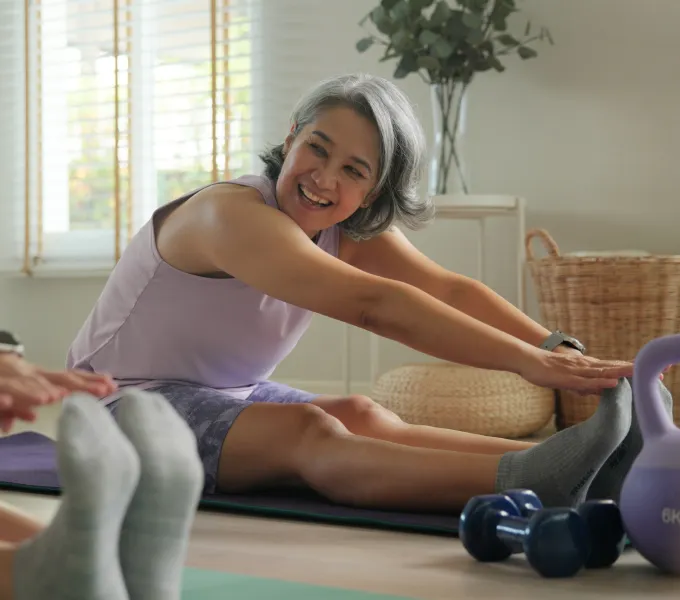
Relax Tight Pelvic Floor Muscles with This Internal Massage
The idea of massaging your pelvic floor the way you would a stiff neck or sore shoulders may seem a little bananas, but, when you think about it, it makes perfect sense. After all, the pelvic floor muscles that surround your vagina can get tight, weak, and sore, just like muscles anywhere else in your body. And because your pelvic floor is one of the major muscular crossroads in your body, like your jaw, neck, and shoulders, it ends up holding onto a ton of tension.
Why is all that tension bad? An overly tense pelvic floor can lead to a host of symptoms including pelvic pain and spasms, bladder and bowel issues, pain with penetrative sex, and delayed, weak, or even painful orgasm.
Pelvic floor PTs like Tami Kent, PT, who owns a private clinic in Portland, Oregon, and trains PTs around the world, recommends internal pelvic floor massage (aka vaginal self-massage) to her patients as a way to release tension stored in their pelvic floor and connect with this often ignored or criticized area of their body in a positive, healing way.
The following is an excerpt from Kent’s best-selling book Wild Feminine: Finding Power, Spirit, and Joy in the Female Body and includes all the details on how and why to give yourself a feel-good (but not that good) vaginal massage.
How Massage Can Loosen Pelvic Floor Muscles
Your pelvic floor muscles play a key role in your body’s overall structural support system, bladder and bowel function, and ability to experience sexual pleasure. All of these functions become inhibited by pelvic tension, which can be released with vaginal massage.
If you have pelvic floor tension, your body will compensate to the best of its abilities, attempting to provide core support even with limited function. Often, the body will compensate successfully until something (injury, pelvic trauma, childbirth, stress, or the hormonal changes of menopause) makes it too difficult. That’s when you may begin to experience more severe pelvic symptoms (like pain, organ prolapse, or urine leakage) that result from these long-term pelvic imbalances.
Internal pelvic floor massage addresses pelvic imbalances before symptoms arise and should be part of a regular self-care routine for all women and individuals with vaginal anatomy. After this massage, patients report having a completely new awareness of their pelvic floor.
How to Give Yourself an Internal Pelvic Floor Massage
Rather than trying to achieve something specific with your massage, simply aim to increase your connection to your pelvic muscles. Just the act of touch alone will enhance your body awareness and help relieve tension. A note of caution: Internal pelvic floor self-massage should not be attempted while pregnant or until at least eight weeks postpartum.
Find a comfortable and private place and a position that allows you to easily access your vagina.
Step 1: Start with Gentle Pressure
Insert your index finger or thumb into your vagina and touch your pelvic muscles by moving your finger over to the sides of your vaginal opening. Use gentle pressure. You can touch areas simply to focus awareness or you can smooth the muscle fibers in a basic massage stroke.
Note: Do not massage the area over your urethra (at the very top of your vaginal opening) or your rectum (at the bottom); these areas are especially sensitive.
Step 2: Pay Attention to What You Feel
The first few times you do vaginal massage, just become familiar with the sensations of your internal pelvis. Try to touch and notice, rather than attempt to change, the areas of tension in your pelvic floor.
If you're working with a pelvic floor physical therapist, it can help to make a note of where you feel tightness or tension. Imagine a clock face (with 12 located above your clitoris and 6 located above your anus) and jot down comments like "found a tender spot 1-inch into vagina at 4 o'clock."

Step 3: Experiment with Deeper Pressure
In addition to using light strokes (as if smoothing or sculpting the muscles) while moving your finger from the front of your internal pelvis to the back on each side, try using deeper pressure on trigger points. When your fingers arrive at a spot that is noticeably tense or tender, slow your breathing and aim to soften that area of tension by increasing your connection to it as you massage it with circular movements or apply steady pressure on that area.
Listen to your body and do only what it enjoys. You do not need to release all the tension; releasing even a fraction will begin changing your core patterns of pelvic muscular imbalance.
Step 4: Massage Further Into Your Vagina
Move deeper inside your vagina and to either side toward your internal hip joints (an area that commonly holds pelvic tension). Start with a light stroke, noting how your body feels in response. If you hit painful or tight spots, you can experiment to see what it feels like if you hold a little pressure there or massage with a circular motion. If that doesn't feel good, return to a lighter stroke.
Your massage doesn't have to last long or achieve any goals. Simply stop when it no longer feels good. Avoiding pressure that feels too intense will help you build positive associations with vaginal massage, so you can look forward to the next one.
Internal Pelvic Floor Massage FAQ
The best way to do pelvic floor self-massage is to listen to your own body and do what feels right, but questions are bound to come up. Below are some general answers. Don’t hesitate to book a visit with a pelvic floor physical therapist to get more personal advice.
What am I trying to do?
The main goal is to establish a positive connection with your body. You are becoming familiar with your own internal pelvic area and learning how to read and communicate with your core. With hands-on massage, you are soothing your body. Bodies respond to touch, and respectful and loving touch can change and enrich certain patterns in the way we feel and respond to the world. By working with your pelvic floor, you will support your body in realigning with the core balance as its norm.
What are the benefits of internal pelvic floor massage, aka vaginal massage?
Internal pelvic floor massage increases your sense of deep relaxation because it reduces tension and increases cellular flow in a central region of your body. It improves your overall pelvic muscular health, strength, and vitality, enabling these muscles to enhance their function as your core structural support. By encouraging the physical well-being of your pelvis, you become more energetically present in your pelvic area and able to access the energy resources it contains. You may also notice increased sensation and muscular tone in your vagina, as well as enhanced sexual arousal and enjoyment.
How often and for how long should I do internal pelvic floor massage?
If you are healing from pelvic pain or a particular pelvic event (childbirth, miscarriage, medical procedure, or period of increased stress) or just reestablishing a connection to your pelvic area, you might consider two to three sessions a week. Self-care sessions may range from five minutes to half an hour, based on your available time and pelvic needs. As a maintenance program, one to two sessions per month are great. If you notice pelvic symptoms such as heaviness, prolapse, urine leakage, or recurrent pain, it's a signal that it's time to see a pelvic floor physical therapist.
What if I feel awkward?
Keep trying. The pelvic floor is an essential part of your body, with valuable energy and resources for you. You deserve to feel at ease with caring for this place. If you can rub the sore spots in your shoulders, you can rub the sore spots in your pelvic floor. Try to feel and sense, focusing on your sensations and body awareness rather than thinking about it or questioning what you feel with your mind. Even touching your pelvic floor with thoughtful regard and directing your breath there will enable your core connection. Learning how to clear tension in your core and connecting more deeply with your center will greatly enhance your creative flow, your sense of joy, your ability to clear blocks and restore core balance, and your awe for what your body does for you.
What position should I be in?
Experiment until you find a position that allows you to reach your pelvic muscles and be comfortable enough to relax your body. Positions may include side-lying, propped with pillows, sitting in a bathtub, or even standing in the shower. You may reach from behind. Finding an ideal position and refining your massage technique may mean feeling a little awkward for a while, but just as you take care of other parts of your body, you will be able to take care of your pelvic floor with practice and patience.
How far should I put my finger into my vagina?
You may massage very superficially or on the sides of your internal pelvis as far as you can reach; areas of pain and tension may be shallow or deep. You may use your index finger or thumb, whatever works for you. Try to find pelvic tension anywhere in or around your vaginal opening.
How hard should I press?
Your pressure will change depending on your body’s response. Use as much pressure on the muscle as required to release tension. If your pelvic tension begins to increase or you feel your body beginning to guard rather than relax, decrease your pressure or stop the session altogether. Your body may be signaling that it has had enough. Again, use very gentle pressure near the urethra and rectum. Think of your touch as sculpting your pelvic muscles, sometimes light, other times firm, but always moving in smooth lines and working together with your body.
What if I don’t notice any particular pain, weakness, or numbness? Am I doing it wrong?
No, sometimes the vaginal massage is more energetic than physical, and instead of physical changes, you feel energy moving and a state of relaxation like you might experience in a meditation. Images or thoughts may come to mind, you may visualize colors or light, you may become aware of different sensations in your body. You are expanding your ability to connect with the vibrant and healing energy of your creative center.
What if I feel a pulsing sensation or heat as I massage?
These are normal signs of muscular and energetic release, indicating an increased blood and energy flow, and decreased tension. This is just what you want to feel as your pelvic vitality returns.
Is internal pelvic floor massage ever sexually arousing?
Vaginal massage is quite different from sexual stimulation and typically feels more like the relaxation experienced with regular body massage. Also, the release experienced by sex and orgasm is more focal and temporary while the release obtained from vaginal massage can be felt throughout the pelvic area (even into the belly) and tends to be sustained. (Note: Penetrative vaginal sex also supports pelvic health because it massages the inner pelvis and invigorates pelvic energy and blood flow, but it does not address or change long-term pelvic patterns of imbalance.) The vagina is most typically associated with sexuality, but it is helpful to recognize the vagina as more than a sexual place. It is the primary entry to the core and provides access to this area of your body. As you start vaginal massage, you may encounter associations with sexuality — and if you have negative associations, you might have to change these in order to take care of your pelvic floor. Releasing muscle tension in the core with vaginal massage often leads to enhanced sensation and greater potential for orgasm during sexual intercourse because of the increased blood and energy flow available in a relaxed pelvic floor.
I am surprised to find many painful areas in my pelvic muscles; why are they there?
Painful areas, or trigger points, occur in muscles that have chronic tension and are most common in core regions like the jaw, neck, back, hips, and pelvic floor. These core regions are particularly sensitive to the chronic tension that arises from emotional or physical stress. When a muscle has chronic tension, it builds up lactic acid and other cellular debris. The tension constricts the vessels, inhibiting the in-and-out flow that maintains a healthy muscle. Stress patterns tend to be maintained by imbalances in posture, prolonged sitting, or habits of daily living. Trigger points are always worse when stress increases, but they can be completely resolved by increasing pelvic floor muscle health with vaginal massage, restoring core balance, and creating a life of balance to diminish overall stress.
What if a painful spot becomes more painful as I massage?
Applying direct pressure to painful spots (trigger points) in a muscle is a standard massage technique. As you push on this area, the pain will initially increase. But then, as pressure is sustained, the pain will typically dissipate as the muscle softens and releases its tension. This is a useful technique to change patterns of pelvic muscular tension and enhance overall blood flow and energy flow to the muscle. In applying this technique, pay attention to your general body tension. Pain causes a contraction response in the body. If you can breathe toward the pain and continue to relax your body as you apply direct pressure to a trigger point, then increasing pain prior to a release is fine. If, however, you apply pressure for several minutes with no change in muscle tension begins to increase, give your pelvic muscles a break and consider connecting with a pelvic floor physical therapist.
If your pelvic floor becomes chronically painful or you have bladder, bowel, or sexual symptoms, book a visit with a pelvic floor physical therapist. Pelvic floor PTs are experts in getting to the root of symptoms and creating a clear path to healing and recovery.



